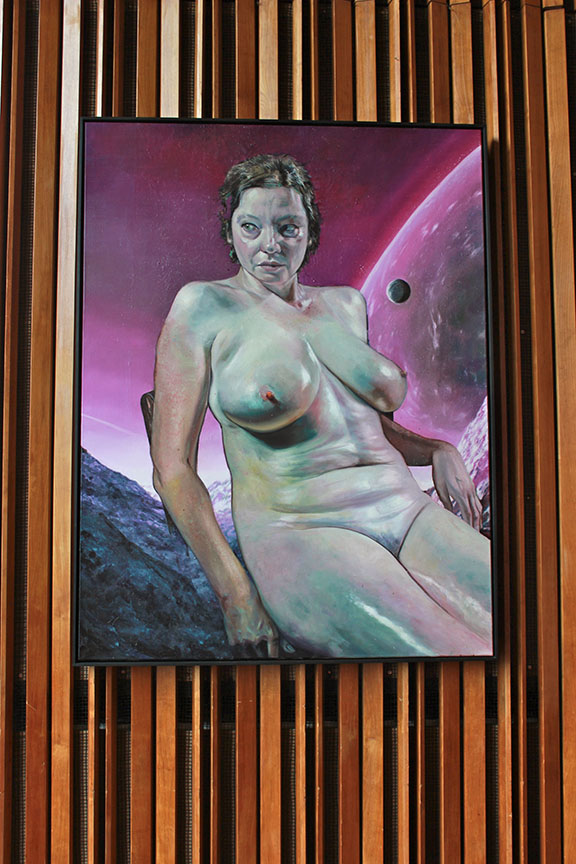KIK 2: "An die Freunde"
KIK 2: "An die Freunde"

On Friday May 2nd, KIK opened its second show, “An die Freunde”, curated by Anna Erickson. We met with the creators to discuss the KIK 2 project and a lively conversation ensued, covering everything from the difficulties brought on by stiletto heels and co-curator diva moments, to the past, present, and future of the Berlin art scene.
The vision for the show was straightforward -- display an eclectic collection of work comprised from pieces by artists living and working in Berlin. Curatorially speaking, Anna took a relatively hands-off approach to her show, inviting artists to participate, but giving them full reign over the pieces they submitted. This allowed for the narrative of the show to be a genuine one, truly about the artists and their work, uninterrupted by a third party mediator. The mission of the project space KIK is to provide a unique space for artwork to be shown, inspired by and reminiscent of the old Tape Modern. This show is just that. It simultaneously celebrates two Berlins -- an older Berlin of the Tape era, internationally know for its independent spirit, and the current Berlin with its relentless energy, perhaps even arguing that despite the presence of rampant gentrification, there is a unique attitude to this city that cannot be commodified. We met with Anna and directors of KIK, Peter Wilde and Christopher Winters, Friday right before the opening, and got a look at what it is like to watch a show come together.
Anna: The concept of the show is really just to honor the "Do It Yourself" culture for artists in Berlin. When they asked me to do the show I did not really want to have a formal concept, I just wanted to honor all of my friends and the amazing culture we lived in at that time. Like a reunion or a nostalgia for a time that might fade away in Berlin. Also, now I live in New York so these kinds of things are not possible there because everyone wants to make money. I work in a big gallery there and its all about sales, so I wanted to do something that was a different energy.
Anna: No. For me, personally, it is over because now I am in New York. It was super sad for me to go back and not have this culture where anything is possible as an artist, curator, or gallerist.
Anna: This was pretty easy because my concept was so open. I just said to them, I want to do this show, you guys make the selection.
Christopher: It is amazing how all of the work has come together though, even though it is very different. There is a thread that runs through the whole thing. I think it is the building and its character that helps with this.
Anna: I have had a pretty easy time with the shows I have put together in the past working with artists. I think they appreciate my feedback and I listen to them as well. I am never trying to force or dictate any kind of concept or idea, so it has always worked very easily.
So on a talented vs. personality balance, what is more important? Would you work with an artist who is amazingly talented but has a difficult personality?
Anna: Overall the quality of the work, the overall aesthetics, are most important to me. But I am a busy girl and I do not have time for drama queens. If I have an idea for a show I do not want to argue with the artists. We are here doing something good for the artists and the community around them so it should never be a difficult thing. Now working with co-curators -- that is a whole different story.
Christopher: Our main thing with KIK was that we knew it was going to be a lot of work, but we were like it HAS to be fun or it is not worth it. And it is really exciting to see everything come together, being able to do something in this space has been really amazing.
Christopher: Some artists came and saw the space before. All of the spaces in the building are so different that you could sort of take the artist and fit them to the character of the space that they are showing in. The former youth club has very strange looking rooms that are more like warehouses, then you have got the formal lounge. Fiona James did a rub in of one of the murals outside and is displaying that piece in the foyer. So she directly reacted to the building.
Have you noticed any distinct differences between curating in New York and in Berlin?
Anna: I have only done one show in New York, but during that show I was so inspired by work I have done in Berlin that I even included some friends of mine from Berlin in it. Things are more open and possible here. In New York no one would do a show like this. They do not have a culture or community that exists outside of a profit-making art gallery. After my first Tape show I was super inspired and went back to New York and said to all my friends "We can do this here! Let us find a warehouse in Brooklyn or something." I actually organized a collective of people even, but we tried to find spaces and they wanted so much rent it never was possible.

Anna: The worst part is standing up all night wearing four inch heels. The best part is seeing people who you have not seen in a while and making new connections. Meeting one person at an opening can change your life forever.